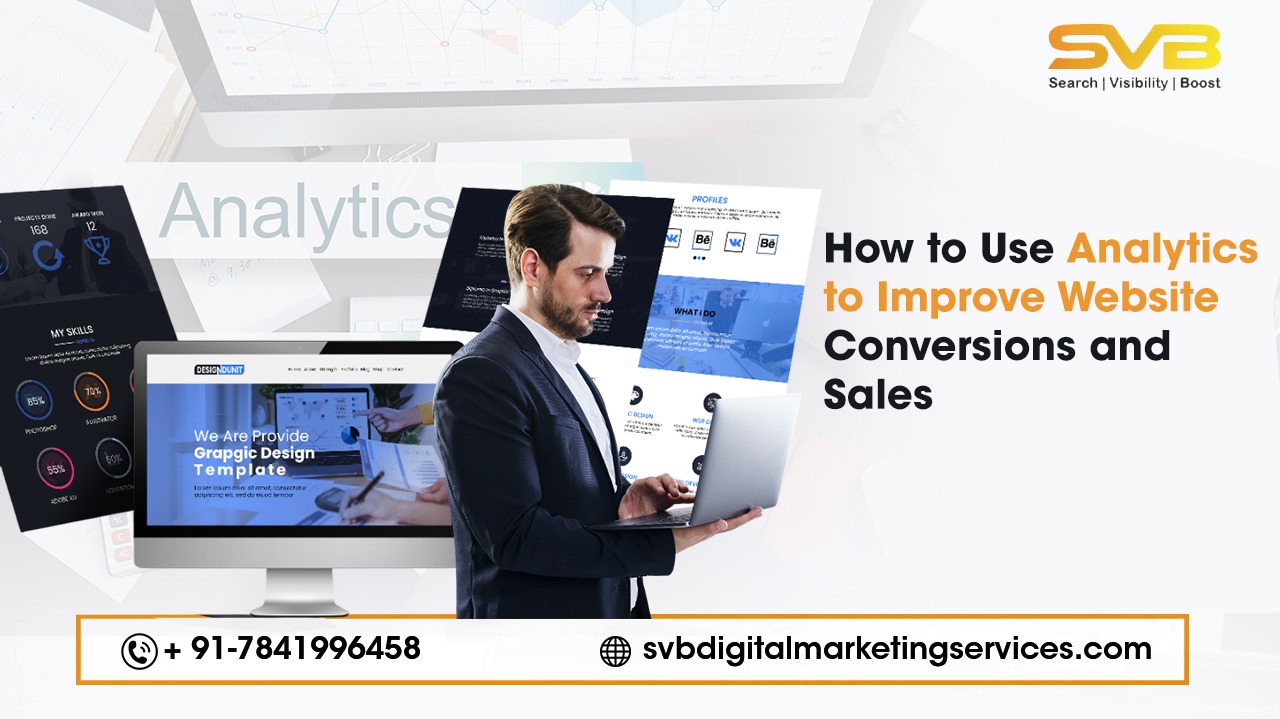Introduction
Your website may be getting decent traffic but is it converting visitors into leads or sales?
Having thousands of visitors is only valuable if they’re taking meaningful actions: filling out a form, requesting a demo, downloading content, or making a purchase. This is where analytics becomes your best ally. By understanding how users interact with your site, you can make informed changes that directly improve website conversion rates and sales performance.
In this guide, you’ll learn how to use analytics not just to monitor your website but to optimize it for real business outcomes.
What Is Website Analytics?
Website analytics involves collecting and analyzing data about how users find, navigate, and interact with your site. Tools like Google Analytics 4 (GA4), Hotjar, and Microsoft Clarity provide valuable insights into:
- Which pages people visit most
- How long they stay
- What actions they take
- Where they drop off
This data helps you move from guesswork to data-backed decisions that improve your site’s ability to convert.
Why Analytics Matter for Conversions and Sales
Analytics helps answer critical questions like:
- Are visitors finding what they need?
- Why are users abandoning key pages?
- Which traffic sources generate the most conversions?
- Which call-to-actions (CTAs) are getting clicks?
By answering these questions, you can:
- Streamline your user experience
- Improve your messaging
- Eliminate friction in your sales funnel
- Focus on channels that actually convert
For B2B companies, where the sales cycle is longer and lead quality matters, this level of insight is crucial.
Key Metrics That Impact Website Conversions
To improve conversions and sales, you must focus on the right metrics. Here are the most impactful ones:
1. Conversion Rate
Percentage of users who complete a desired goal like submitting a form or making a purchase.
2. Bounce Rate
Shows how many users leave after viewing one page. High bounce rates may signal weak content or poor user experience.
3. Average Session Duration
Reveals how long users stay on your site. Short durations may indicate lack of interest or confusing navigation.
4. Exit Pages
Tells you where visitors are leaving. If important pages like pricing or contact are high on the list, something needs fixing.
5. Traffic Sources
Helps identify which marketing channels are driving the most valuable traffic SEO, social, paid ads, referrals, etc.
6. Device Breakdown
Are mobile users converting less than desktop users? That may point to design or speed issues on mobile.
How to Use Analytics to Improve Website Conversions
Let’s break down the steps you can take to turn insights into action.
1. Set Up Goals and Conversion Events in GA4
Before improving anything, make sure you’re tracking what matters.
- Define goals such as contact form submissions, purchases, or newsletter signups
- Use event tracking to monitor clicks on CTAs, form completions, video plays, etc.
- Analyze these conversions by traffic source, device, and user behavior
Tip: In GA4, you can set up custom events for every action that matters to your business.
2. Audit Your Top Landing Pages
Your most visited pages should also be the highest-converting. If they’re not, you’re losing opportunities.
- Use analytics to see bounce rate and average time on page
- Look for drop-off points
- Check whether visitors scroll down far enough to see your CTA
- Improve headline clarity, page speed, and design layout
Tools like Hotjar or Microsoft Clarity can show scroll maps and session replays to visualize behavior.
3. Analyze Exit Pages and Fix Friction Points
Are users leaving from your:
- Pricing page?
- Contact page?
- Product/service detail page?
That’s a red flag.
You might need to:
- Add FAQs to address objections
- Simplify the CTA
- Use social proof (testimonials, case studies)
- Shorten forms or reduce required fields
Voice-friendly content like clear questions (“What’s included in your service?”) helps too.
4. Compare High vs. Low-Converting Traffic Sources
Not all traffic is equal.
Use analytics to see which channels bring users who:
- Stay longer
- View more pages
- Convert at a higher rate
Double down on high-performing sources, and re-evaluate or refine low-performing ones.
For B2B, LinkedIn ads might bring better leads than generic search traffic. Use UTMs to track performance.
5. Optimize for Mobile and Site Speed
Mobile users are often ready to act but only if your site loads fast and displays correctly.
Use:
- Google PageSpeed Insights to fix speed issues
- GA4 to compare conversion rates between mobile and desktop
- Responsive design testing tools to fix layout and usability issues
A one-second delay in page load can reduce conversions by up to 20%.
6. Use Heatmaps and Session Recordings
Sometimes, the best way to understand users is to watch how they behave.
Use tools like:
- Hotjar
- Microsoft Clarity
- Lucky Orange
You’ll uncover:
- Where people click (or don’t)
- Where they stop scrolling
- Confusing design elements
- Dead zones with no engagement
Fixing these friction points can have an immediate impact on conversions.
7. Run A/B Tests on Key Elements
Don’t guess. Test.
Try A/B testing:
- Headlines
- CTA button copy or color
- Layouts and images
- Form length
Even a small improvement (like increasing CTA clicks by 10%) can translate into significantly more leads or sales over time.
Use tools like:
- Google Optimize (sunset, but alternatives include VWO or Optimizely)
8. Segment Your Audience for Smarter Personalization
Use segmentation in GA4 or your CRM to analyze performance by:
- New vs. returning users
- Device type
- Geography
- Lead source
This allows you to create personalized landing pages, ads, or offers that resonate better with each segment which increases conversion probability.
Best Analytics Tools to Support Conversion Optimization
| Tool | Purpose |
| Google Analytics 4 (GA4) | Tracks website traffic, user behavior, and conversions |
| Google Tag Manager | Enables event tracking without coding |
| Hotjar / Clarity | Heatmaps, session recordings, scroll tracking |
| Looker Studio | Visual dashboards for reporting and KPIs |
| VWO / Optimizely | A/B testing and optimization |
| HubSpot / ActiveCampaign | CRM + behavior-based automation and lead tracking |
Final Thoughts
Website analytics gives you the visibility you need to improve every aspect of your digital experience. By tracking the right metrics and acting on real user behavior, you can:
- Increase form submissions
- Reduce bounce and exit rates
- Improve lead quality
- Maximize ROI from all marketing efforts
Don’t just measure your website. Improve it one insight at a time.
Ready to Turn Data Into Sales?
At SVB Digital Marketing Services, we help B2B brands transform their website performance through conversion-focused analytics and CRO strategies. From setting up GA4 the right way to running A/B tests and fixing drop-off points, we’re here to make your website work harder.
Visit: www.svbdigitalmarketing.com
Book a free consultation
Follow us on LinkedIn for weekly insights

